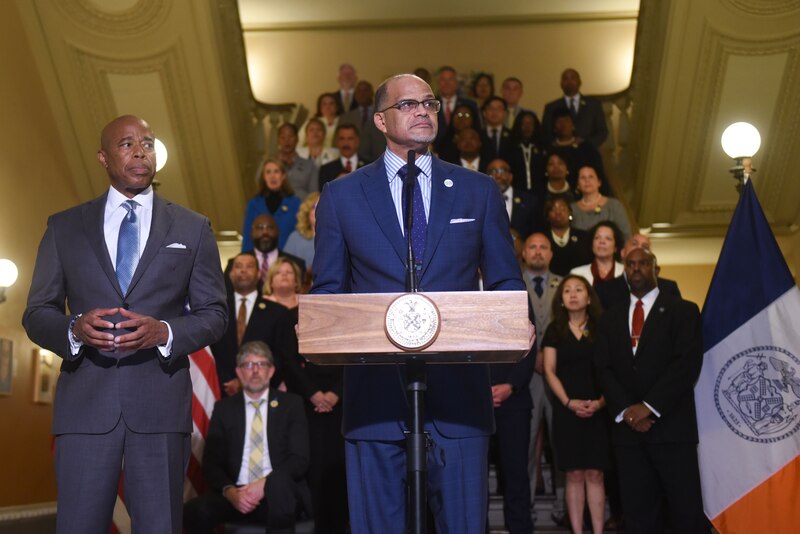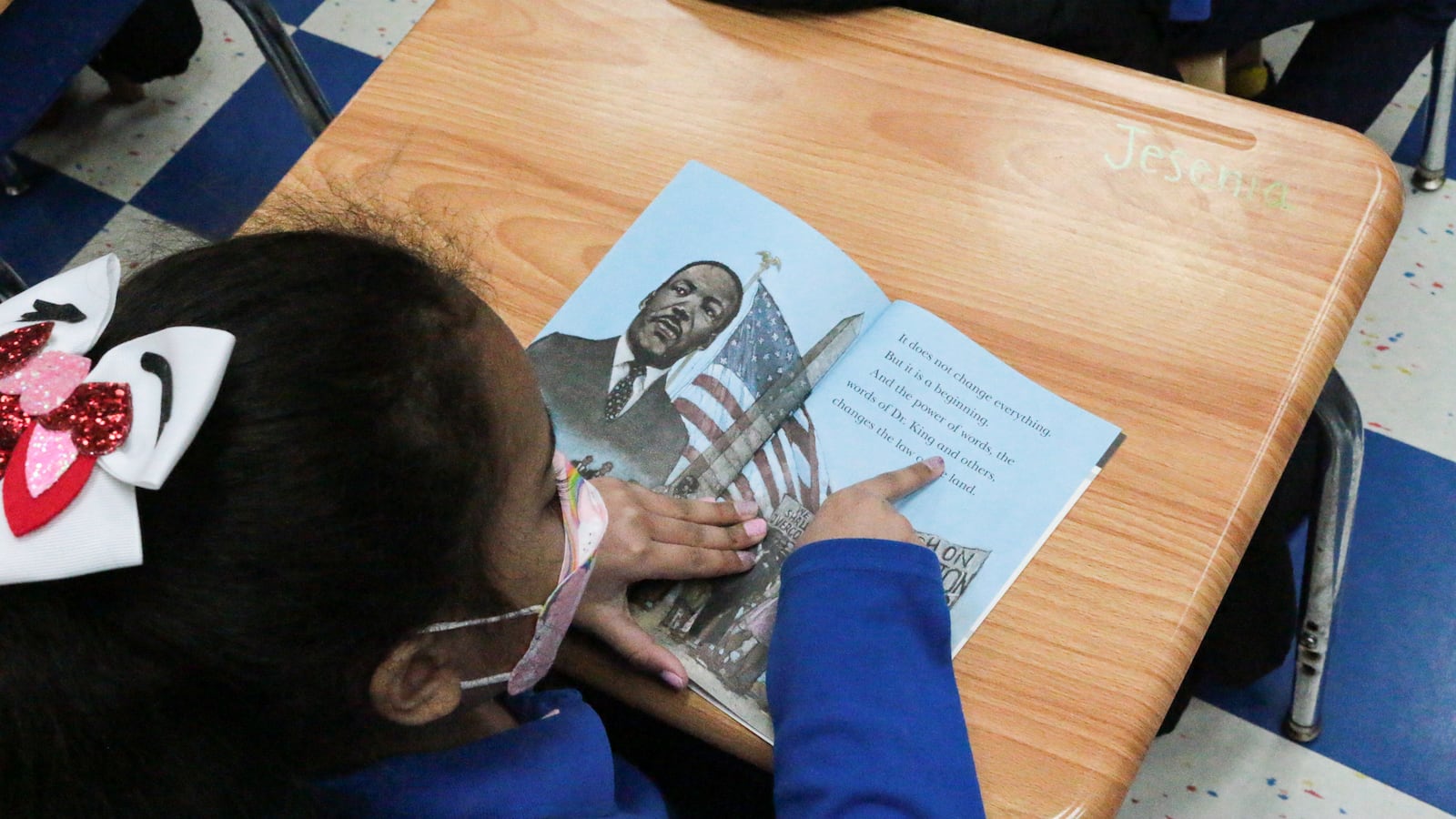Sign up for Chalkbeat New York’s free daily newsletter to keep up with NYC’s public schools.
Under NYC’s aggressive literacy push announced earlier this month, officials are mandating all elementary schools use one of three reading curriculums.
One is proving to be far more popular than the others.
Thirteen of 15 local superintendents charged with selecting their districts’ reading curriculum in this first phase of the rollout picked Into Reading, a program published by Houghton Mifflin Harcourt.
The education department vetted all three of the mandated reading programs, including Wit & Wisdom and EL Education, officials said. And all three received high marks from the independent curriculum reviewer EdReports.
So why is Into Reading far and away the most popular option among superintendents?
Curriculum experts and department insiders pointed to a series of interlocking factors that may have helped Into Reading elbow out the competition. The program is widely perceived as easier for teachers to implement, especially with little time remaining before deploying it in September. Plus, Into Reading has a Spanish version, which may appeal to superintendents who oversee many dual-language and bilingual programs.
Houghton Mifflin Harcourt may have also benefited from a savvy marketing strategy, current and former department employees said. When the pandemic forced school buildings to shutter in March 2020, the company quickly made a slew of free digital materials available to the city’s public schools, including Into Reading and its Spanish counterpart.
“It was a huge help. We were able to make sure that schools had the digital resources they needed during remote learning and hybrid learning,” said a current education department employee familiar with the city’s literacy efforts who spoke on condition of anonymity.
Within two years, the education department had added Into Reading to its approved list of curriculum offerings. That meant if principals choose Into Reading, the cost was subsidized, though they were still free to use their own budgets to purchase other curriculums.
“Houghton Mifflin made a strategic decision during the pandemic and they hoped it would pay off,” the official said. “And it did.”
EL Education, one of the other programs included in the new mandate, was also on the approved list at the time. All three curriculums covered by the new curriculum mandate, including Wit & Wisdom, will be similarly subsidized.
A spokesperson for Houghton Mifflin Harcourt downplayed its decision to make materials free as a key driver of superintendents’ decisions to mandate their product. “There were already hundreds of schools across the city using HMH reading resources,” Bianca Olson, a company spokesperson, wrote in an email. “These partners have seen strong results and they want to continue that momentum in support of student achievement.”
A city education department spokesperson noted that Houghton Mifflin Harcourt was one of more than a dozen vendors that provided free digital resources during the pandemic. But officials have generally not collected or published comprehensive curriculum data over time, making it difficult to ascertain the full impact of the company’s strategy.
The education department also declined to say how much they are projected to spend on Houghton Mifflin Harcourt materials and training now that Into Reading is being widely mandated, saying they are still working on creating cost estimates.
Focus turns to ‘science of reading’
Houghton Mifflin Harcourt’s move to make its materials free came at an opportune moment. Before the pandemic struck, many schools were already in the process of reconsidering their reading curriculum choices, multiple curriculum experts said, pressured in part by a small army of literacy coaches dispatched to schools.
A growing movement backed by years of research, known as the “science of reading,” was persuading more school leaders to back away from “balanced literacy” — an approach that sought to foster a love of literature by allowing students ample time to independently read books of their choosing. It also sometimes included dubious methods, such as encouraging students to use pictures to guess at a word’s meaning instead of focusing on the letters and sounds themselves.
“Every school that I was in was in the midst of changing,” said Heidi Donohue, an early literacy expert at Teaching Matters, an organization that works with city schools to improve reading and math instruction. “They were really talking about, ‘Is the curriculum high-quality? Is it meeting the needs of our kids?’”
More recently, schools Chancellor David Banks has declared that balanced literacy is not an effective approach, often singling out a curriculum developed by Lucy Calkins at Columbia University’s Teachers College — one of the most popular reading curriculums in the city’s public schools. (Heinemann, the publisher of Calkins’ curriculum, is also a division of Houghton Mifflin Harcourt.)

Some observers said they were not surprised that Into Reading has become a popular choice in New York City, since it is also widely used elsewhere. An Education Week survey found that Houghton Mifflin Harcourt’s reading offerings are among the five most popular early reading programs in the country, in large and small districts alike.
Others emphasized that its lessons may seem easier to unpack: Donohue noted that many lesson plans from the teachers manual can fit on two pages. Experts also said Into Reading has common DNA with curriculums that schools have used for years that are structured as anthology-style textbooks with passages written specifically to teach reading skills. (In education jargon, those programs are often referred to as “basals.”)
“A basal-type program is going to have much more structure in the teaching, in the lesson plan itself,” said Esther Friedman, who directed the city education department’s literacy efforts until 2020. Although Friedman said the other two programs also have detailed teacher guides, Into Reading may feel “a little bit more manageable.”
In Brooklyn’s District 16, which covers a large chunk of Bedford-Stuyvesant, teachers got a head start. About two years ago, nearly all of the district’s elementary schools adopted Into Reading, and the new superintendent, Brendan Mims, plans to keep the program in place.
Even though the district’s schools have already used Into Reading, Mims said there’s still room for improvement. “We haven’t hit that bar yet,” he said, in terms of implementing it as effectively as he thinks is possible. He’s hopeful that a more centralized approach to training will help. “Now, teachers and principals and district staff can work together to make sure that they’re getting what they need,” he said.
No curriculum checks every box
Into Reading has the potential to reshape reading instruction across hundreds of elementary school classrooms. That number could grow as more than half of superintendents aren’t implementing the curriculum mandate until September 2024.
Curriculum experts offered mixed feelings about the popularity of Into Reading. Nearly all said that it has many strong elements, including challenging readings, and a broad array of lessons that build vocabulary, spelling, and grammar skills.
But some also said in an effort to sell the curriculum to the widest array of districts, Into Reading is jam-packed with different strategies and resources, similar to other anthology-style programs. That will require teachers to be selective about which lessons to teach.
“Teachers really have to plan for this, and they have to understand that they’re not going to use all of the resources,” Merryl Casanova, a literacy coach who works with schools in the Bronx, previously told Chalkbeat.
Donohue, of Teaching Matters, said the program can be used effectively, but there are also elements of it that feel “watered down.” She said the texts and vocabulary tend to be slightly less challenging, and the other two curriculums include deeper student discussions and units with more sophisticated themes.
The other two programs “bring a higher quality of text and expectation for kids,” Donohue said. A New York University report also found that Into Reading materials are not culturally responsive, though Houghton Mifflin Harcourt has disputed that characterization and some educators told Chalkbeat the materials do speak to the diversity of New York City’s student body.
Other observers said that EL Education and Wit & Wisdom are somewhat more focused on exposing students to nonfiction in an effort to boost their background knowledge of topics they’re likely to encounter in the future, a strategy meant to boost students’ ability to understand texts about a wide range of subjects.
Still, experts emphasized that all three curriculums come with tradeoffs. And much of the success of the literacy mandate may rest on whether educators buy into the changes — which can be tricky given there was not a public input process. The quality of the training they receive is also critical to the program’s success.
“Really none of the three [curriculums] give a teacher all of the tools for teaching what needs to be taught,” Friedman said. “That has to come from the professional development.”
With just over three months until the next school year begins, there is limited time to fully prepare.
Alex Zimmerman is a reporter for Chalkbeat New York, covering NYC public schools. Contact Alex at azimmerman@chalkbeat.org.

